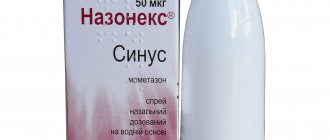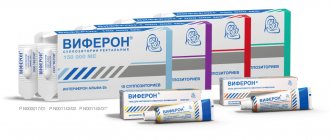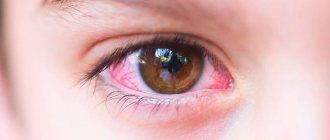About the disease
Herpetic infection is a collective concept that is used to refer to diseases that are provoked by different types of the virus of the same name.
Traditionally, in pediatric practice, pathology caused by type 1 is encountered. This is the so-called labial herpes (rash on the lips). Its peculiarity is its chronic course. It is impossible to completely get rid of the pathogen. With adequate treatment of a child with symptoms of labial herpes, stable remission can be achieved. However, at this time the virus “hides” in the nerve ganglia (ganglia), where it can remain inactive for as long as desired. When favorable conditions arise (primarily decreased appetite), it is activated again. Another common form of herpes infection that can occur in children is varicella (chickenpox). The disease is provoked by the herpes virus type 3. It is important to remember that after successful recovery, the pathogen also goes into a latent form and persists in the nerve ganglia. The risk for the patient may be a reoccurrence of the infection. The type 3 virus, when reactivated, can cause herpes zoster, which is characterized by a more pronounced clinical picture with a deterioration in the child’s well-being and the appearance of rashes along the intercostal nerves.
The specialists of the SM-Doctor clinic have extensive experience in early diagnosis and treatment of all pathologies caused by herpes viruses. Doctors provide the necessary monitoring and quality treatment for children with any form of herpetic infection.
Herpes symptoms
Labial herpes is the simplest and most harmless form of the disease, which occurs most often in children. Apart from discomfort for the baby and parents, in most cases the disease is not accompanied by serious consequences. Typical clinical picture:
- the formation of painful blisters filled with serous fluid in the lip area;
- itching and burning in places where skin elements appear;
- loss of appetite. Breasts may refuse to breastfeed due to pain during feeding;
- general weakness, lethargy, emotional lability;
- increase in body temperature to 37-37.5 ° C (rare).
With adequate treatment, signs of the disease can disappear after 3-4 days.
Chicken pox is a typical representative of “childhood infections”. The disease is accompanied by the appearance of rashes with serous contents throughout the body of a small patient. A characteristic feature that allows you to quickly differentiate chickenpox from other infectious pathologies is the obligatory presence of pustules on the scalp and the formation of crusts after removal of the blisters. The disease is also accompanied by a rise in body temperature to 38-39.5 ° C. The severity of the pathology depends on the individual characteristics of the child’s immune system and the aggressiveness of the pathogen.
Herpes zoster is accompanied by:
- the occurrence of rashes along the intercostal nerves;
- severe pain in the area where the pustules spread;
- high fever;
- pronounced general intoxication syndrome.
If you detect at least one of these symptoms, you should immediately consult a doctor. SM-Doctor specialists point out that chicken pox and herpes zoster are diseases that require isolation of a small patient in a hospital to monitor his condition and prevent the spread of the pathogen to other family members and the environment.
Cold on the lips of a child. How to treat
14.09.2021
Not all viral diseases that cause a pandemic are recent “innovations.” Certain diseases are associated
to humanity from very ancient times, before the construction of the pyramids of Egypt. The infectiousness of some is at such a high level that there is no chance
It is disproportionately more important to identify an infection than to exclude its occurrence. This article will talk about the herpes simplex virus (HSV-1 and HSV-2).
Infection almost always occurs in childhood, and in this case it is important to understand how to help the child cope with
unpleasant symptoms and avoid the spread of the virus.
Once it enters the body, the herpes virus accompanies a person throughout his life. Most of the time the disease is in an inactive phase.
With optimal functioning of the immune system, the herpes virus practically does not make itself felt, only occasionally the manifestation of symptoms follows, and then only if it
is in the acute phase.
Symptoms
The expression of symptoms of the disease varies and depends on the age of the child. A more severe course of the disease is observed with primary infection.
At this point, the baby has not yet developed antibodies to this type of virus. The duration of the incubation period is 2–12 days (most often 4 days).
In young children, the immune system is not strong. Therefore, the manifestations of the disease are most noticeable. For example, herpetic stomatitis is characteristic of
child from 6 months to 3 years. The disease tends to begin suddenly. High fever, chills, and general intoxication appear. Baby can
lose appetite. But it may also happen that refusal to eat is caused by discomfort in the oral cavity. In this case, swelling of the lips, gums , tongue, hard
and soft palate. Over time, herpetic blisters form on the tongue and mucous membranes. After the bubble bursts, shallow
erosion. Very often there is an increase and painful sensations of the lymph nodes. The acute phase lasts from 7 to 12 days.
Other manifestations
Skin lesions from herpes infection are the most common manifestation of recurrent HSV-1 infection. Manifestations of herpes can be found on the lips, wings
nose and around the mouth . In some cases, you may notice the appearance of blisters on the torso, arms or even buttocks. They are accompanied by burning and itching. Further
either the bubbles open or dry out and form a crust. When a relapse occurs, as a rule, the same areas of the skin are affected.
cover. Symptoms may include:
· headache; · heat; · myalgia; · polyadenopathy; · lymphadenitis; · enlarged liver and spleen.
With a localized form of the disease, the process will be completed in 6-12 days, and with a widespread form, completion will take up to 2-3 weeks or more.
Prevention of herpes in children
immune system should be supported and not provoke relapses of the acute course of the disease.
Symptoms such as:
· stress; · vitamin deficiency; · intense tan; hypothermia; · inadequate and unbalanced nutrition.
If symptoms occur, you should consult a doctor who will conduct an examination and prescribe treatment. Ointments and creams are usually indicated
multivitamins, immunomodulators and antiviral drugs. Of course, it is quite difficult to explain to a child how to take the necessary precautions,
to avoid herpes infection. But older children need to be familiarized with the prevention of the spread of the disease and rules of behavior
with the herpes virus at the stage of emerging blisters and in the process of their healing.
The child should be told that:
· Do not touch the affected areas of the skin with your hands or objects; · you need to use individual hygiene items and utensils (the best option is to use disposable utensils); · Do not tear off the crusts and try to squeeze out the contents of the bubble; · no kissing; · To avoid re-infection, you should avoid using cosmetics for children.
These are the simplest but necessary rules of behavior that will help avoid infection, and if it occurs, then the further spread of the viral infection.
Be healthy! There are contraindications; you must read the instructions for use and consult a specialist.
Published in Children's Diseases Premium Clinic
Causes of herpes
All variants of herpes infection occur against the background of the activity of the virus of the same name of different types. Since upon initial penetration into the human body the pathogen no longer leaves it, it is important to know the factors that can provoke the activation of the disease:
- hypothermia;
- seasonal colds;
- any conditions that provoke a decrease in immune defense (poor nutrition, hypovitaminosis and others);
- exacerbation of chronic somatic diseases;
- contact with an infected patient.
The virus is transmitted by airborne droplets, so it is extremely difficult to completely prevent a child from encountering pathogenic particles.
How can you get infected with herpes
The content of the article
The disease is caused by the herpes simplex virus (HSV, Herpes simplex virus). Of the eight types of this pathogen, genital lesions are the result of two infectious agents. HSV-2 causes 80% of cases of the disease, and HSV-1 - 20%. There are also combined infections, in which both viral types are to blame.
There is a misconception that herpes on the lips and genitals are completely different diseases. In fact, both types of pathogens often “swap places” during domestic infection and oral sex. And both infections are equally dangerous.
Both types of virus are transmitted:
- For all types of sexual contact - vaginal, oral, anal, during which the virus enters the body through microdamage to the mucous membrane. You can also become infected from a partner who does not have rashes on the genitals or other manifestations of the disease. This condition is possible with strong immunity, when the virus lies low and waits in the wings. A person becomes a carrier of a herpes infection, but does not experience any health problems.
- Through common objects - washcloths, sponges, bed linen, towels. A person with a cold sore caused by the type 1 virus can become a source of genital herpes infection.
- During autoinoculation (self-infection), when the patient transfers the pathogen from the face to the genitals.
- A child becomes infected from a sick mother when the virus penetrates from the vagina into the uterus or transplacentally through the placenta. During childbirth, infection occurs as the newborn passes through the birth canal.
Statistics of hidden and overt forms of herpes
The body cannot overcome the pathogen on its own. The virus settles in the roots of the spinal cord, and the infected person continues to live with the disease throughout his life.
The pathogen can remain in the body for many years without causing symptoms. Therefore, it is impossible to know without testing for herpes whether a person is infected with the virus. According to WHO, type 1 herpes, which causes a rash on the lips and genitals, affects 67% of the world's inhabitants, and type 2 affects 11% of people. Only 20% of the disease occurs in the classical form, which is beyond doubt. In the rest, the course of the disease is latent or asymptomatic.
Diagnosis of herpes
"SM-Doctor" is a multidisciplinary clinic specializing in providing high-quality medical services to children of any age. Diagnosis of herpetic infections in our center is carried out according to the standards used in leading clinics in Europe and the world. Our specialists establish a preliminary diagnosis at the stage of the initial examination of the child. Depending on the severity of the clinical picture, the necessary auxiliary diagnostic procedures are selected:
- a set of standard laboratory tests (general blood test, urine test, blood “biochemistry”, etc.);
- specific serological tests (ELISA) to detect antibodies to a specific type of virus in the patient’s blood;
- Polymerase chain reaction (PCR) is a highly informative diagnostic method that allows you to detect the presence of a virus in a child’s body with up to 99% accuracy.
"SM-Doctor" is a multidisciplinary center. Thanks to this, if necessary (for example, if complications develop), our patients can be examined by a wide range of specialists in different fields. If the attending physician, in addition to infection, suspects a pathology of internal organs and systems, he refers the sick child for consultation with a cardiorheumatologist, ophthalmologist, neurologist and others. In a short period of time, the child receives a full range of diagnostic services aimed at identifying any abnormalities in the functioning of the body.
Symptoms
A cold on the lips in a child’s body causes symptoms of intoxication:
- the temperature rises, sometimes only to subfebrile levels;
- nagging pain appears in the limbs;
- headache occurs;
- enlarged lymph nodes in the neck or submandibular area;
- the child is naughty or crying.
After a few hours or the next day, itching on the lips begins. Then the following manifestations of infection occur:
- Small bubbles appear on the border of the red border of the lips. They are filled with transparent content.
- Over 10-12 hours, the rashes increase in size and merge together.
- After some time, the membrane of the bladder bursts and an ulcer forms. It becomes crusty and gradually heals within 3-4 days.
Herpes blisters are also localized in the corners of the lips. You can often notice that first a bubble popped up near the nose, on the upper lip, and later the rash spread to the skin in the nasolabial triangle.
Treatment of herpes
SM-Doctor doctors select treatment for herpetic infection for each child individually.
Our specialists prescribe medications depending on the severity of the clinical picture of the pathology and the presence of concomitant diseases. The following means are traditionally used to combat the virus:
- acyclovir is a specific drug to destroy the pathogen;
- antipyretic medications (paracetamol, ibuprofen) for fever above 38°C;
- auxiliary medications (painkillers, antiallergic and others).
Prevention of herpes
The basic rules that will help reduce the likelihood of infection with viruses of the herpes family are:
- hand washing;
- limiting contact with sick people;
- nasal instillation with saline solutions during the off-season.
There is now a vaccine against chickenpox. Vaccination helps prevent infection and/or development of severe forms of the disease. “SM-Doctor” is a multidisciplinary medical institution that provides effective treatment to children facing various diseases. Herpetic infection in any of its manifestations is not a problem. The main thing is to schedule a consultation with our specialists on time. Contact us!
Complications of herpes in infants
What are the complications of herpes in a child? In infants, herpes can be complicated by the following types of diseases:
- the cardiovascular system is affected;
- cerebral palsy;
- paralysis;
- disturbance in the hematopoietic process;
- encephalitis;
- herpes eyes;
- meningitis;
- hepatitis;
- eczema Galoshes.
To prevent the development or occurrence of the disease, it is worth making sure that the baby’s immune defense is at a high level. It is necessary to carry out hardening procedures and ensure that the child spends enough time in the fresh air. It is important to maintain a certain temperature and humidity in the nursery.
During the prenatal period, expectant mothers need to be screened for the herpes virus. Pregnant women should also take precautions to avoid infection. For example, do not communicate with people who carry this virus, do not use their things, etc.











